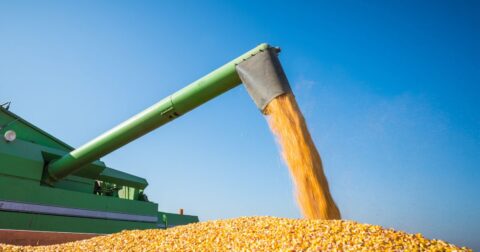Feature
Heat Exhaustion, Amputated Fingers, Crushed Limbs: The Hidden Cost of American Turkey
Food•8 min read
Explainer
Monoculture impacts our food system and environment — but most people have only a vague idea what it entails.


Words by Björn Ólafsson
The food and farming industry experienced a technological boom in the 20th century. To feed a growing population more efficiently, farmers began shifting to a farming style called monoculture — growing a single species for harvest in a single area. Despite the economic and efficiency advantages, some scientists have criticized this practice, calling it harmful to soil and biodiversity, as well as contributing to environmental problems worldwide. So, what is monoculture farming, and do we need to stop it?
A monoculture farm describes an agricultural operation growing one type of crop, say corn or wheat, in a specific area of land. Sometimes, a monoculture can refer to planted forests or other human-made ecosystems that primarily contain one species of plant, like lawns. It can also include farming one species of animal in a single area.
When this crop is sown every single year without fail, this is known as monocropping. These are two related, but not synonymous, concepts — one farm may use monoculture but not monocropping. Polyculture is when a field has more than one crop at once, usually intermingled together.
Monocultures have no other requirements — they can be organic or laden with synthetic pesticides, intended for humans or given to farmed animals, grown by a family farm or a megacorporation. Thus, there is variability when it comes to their environmental impact. While monocultures can improve farming efficiency, they have unintended negative consequences on the environment — especially on the soil.
By some estimates, monoculture fields cover 80 percent of agricultural and arable land. In the United States, 440 million acres are set aside for monoculture farming alone, much of it grown to feed farmed animals.
Monoculture farming grew in popularity because the focus on efficiency enabled producers to maximize their yields, typically of commodity crops like soy and feed corn.
The biggest advantage is also the most straightforward: monoculture is a simple method of farming, one that doesn’t require complicated strategies or techniques. By only having one crop, farmers don’t have to have multiple types of farming equipment or methods, which brings costs down. This streamlines many aspects of farm life, and enables farmers to use their time more efficiently.
Since farmers need less specialized equipment and usually less labor, monocultures are normally cheaper to produce on a given area of land. However, some economic analysis argues that these cheap costs end up costing more in the long run — growing one crop over and over degrades soil, and farmers in turn use more fertilizer to maintain high yields. Therefore, these lower costs may only exist in the short-term.
In the U.S., most farming subsidies go to producers for commodity crops, a large portion of which are monoculture crops. Less than two percent of farming subsidies go towards fruits and vegetables. Instead, the vast majority props up commodity crops like soy, corn and wheat, which are usually grown in monoculture farm operations.
Growing plants is a difficult science, one that involves soil acidity, temperature, weather, humidity, natural events, pollination, insects, sun coverage and a host of other factors. Because a monoculture operation allows farmers to focus their energy on improving conditions for a single plant species, they can maximize the eventual harvest.
For many cereal crops, a monoculture strategy enables higher yields than polycultures, according to analysis from Washington State University. The researchers note that farmers who utilize monoculture should rotate their crops between seasons to protect the soil.
Given the higher yields, lower costs and more efficient techniques, it’s no wonder that monoculture creates more profit for farmers than more complex methods.
Pests, insects and diseases can sweep through a monoculture field extremely fast, since there is only one plant species and no other natural barriers. Some conventional farmers use weedy borders and other nature-based approaches to combat this effect, but many monoculture farmers rely heavily on synthetic pesticides. Pesticides can have negative effects on the environment, especially if they are misapplied: polluting the soil and water, harming native insects and bird populations and even contributing to air pollution.
Pollinators like bees, insects, birds and more, flourish in diverse wild landscapes rather than monoculture fields. Some pesticides harm these animals, certainly, but it’s more than that. Large, rolling fields of just one crop don’t give pollinators room to land, feed, or, well, pollinate. A wild bee would likely prefer different flowers, fruits and squash to a large field of one type of corn. It’s no wonder that monoculture practices — including using honey bees to pollinate massive almond farms — contribute greatly to reductions of native pollinator species.
Large fields of the same species make it harder for nearby plants and animals to thrive. There are fewer flowers for pollinators, less food for animals to eat and less space for plants to grow. In other words, areas characterized as monoculture have drastically fewer plant and animal species.
Plants need specific nutrients from the soil. If one plant species is grown again and again on the same field, the soil can eventually become drained of those specific nutrients, harming its composition and reducing the quality of plant life. However, keep in mind that monocultures don’t necessarily grow on the same field every year; this is called monocropping.
Monocropping can be disastrous for soil health. Tests on monocropped fields found that their soil composition was two to three times worse when compared to perennial grasses nearby. They were lower in bacterial matter, fungi, nutrients and other microbes — all critical for sustainable soil health.
Because of the deteriorating soil health, monoculture farms often resort to extensive uses of fertilizer to keep up harvest yields. Overusing fertilizer can harm the environment, especially by contributing to eutrophication (when excess nutrients in bodies of water harms local wildlife). The majority of fertilizer becomes runoff; almost two-thirds of all fertilizer use on crops becomes runoff, in fact. This can have devastating effects on local communities, both human and nonhuman.
Farm income hinges on the price of a single product, such as corn. Therefore, if that product has a downturn on the market one year, or if environmental conditions decrease output for a given harvest, the farmers will lose money. These risks can be assuaged by having more than one type of monoculture crop within a farm, or by utilizing polyculture.
The first way to reduce our dependence on monoculture farming may seem counterintuitive: eating less meat. Many monoculture crops end up in animal feed, not on human dinner tables. For example, soy monoculture in South America is increasing deforestation and harming local communities — but 77 percent of these products are used in meat and dairy production, not tofu. Globally, animal agriculture uses 75 percent of agricultural land, including a majority of monoculture crops.
Because the majority of monoculture crops feed animals, not humans, reducing our global meat consumption, especially in meat-heavy Western nations, would go a long way in reducing monoculture use. Choosing sustainably grown fruits and vegetables and avoiding overly processed foods also helps with mitigating monoculture use.
Other than shifting our global diet from meat to plants in order to save agricultural land, governments can also pass laws regulating the amount of monoculture and monocropping. While the USDA began investigating the negative effects of overtilling the soil through monoculture in 2014, subsidies still encourage farmers to use these environmentally-damaging practices. Federal agencies can create legislation to promote cover cropping, intercropping, agroforestry or regenerative practices, instead of subsidizing commodity crops.
Monocultures can harm local animal and plant species because these large swaths of land will only have one crop on them, making it difficult for other species to thrive. Areas near monoculture plantations in the global south have less tree and plant diversity.
One single species of plant can draw out nutrients from the soil, especially nitrogen, which causes it to deteriorate. This makes it harder for fungi, bacteria and other microorganisms to thrive in the soil, which causes even more problems down the line. Farmers may supplement with fertilizers, which can sometimes overcorrect and throw off the balance of nutrients even further. Over time, other plants may not be able to take root as easily, which may eventually lead to erosion.
Farmers can avoid monocropping by rotating crops between fields in between harvests. This doesn’t avoid all the problems of monocultures (we’d still have to contend with pesticide usage and potential biodiversity loss) but it would help improve the soil long term.
Organic fertilizers can be less likely to contribute to nutrient runoff compared to chemical fertilizers, though applying too much of any type of fertilizer can add to the problem. Organic farming methods are also intended to benefit local flora and fauna — especially insects, who are crucial to maintaining our ecosystems.
Reducing the amount of pesticides would mitigate some of monocultures’ effect on biodiversity and local insect populations as well.
The act of integrating trees and shrubs into farmland, known as agroforestry, also helps reduce the negative effects of monocultures.
Polycultures are tracks of land where more than one species of crop is grown at the same time. There are many forms of polycultures: intercropping (growing multiple species in proximity), companion planting (growing two plants side-by-side), or cover cropping (planting non-commercial crops in between rows of the main crop). Overall, they offer an alternative to monoculture use, although they have their drawbacks as well.
Polycultures don’t harm soil health or local biodiversity, nor do they contribute to eutrophication or erosion as much as monocultures do. However, polycultures may have a lower efficiency and output, which is why some farmers gravitate towards monoculture systems.
Monocultures nearly always harm biodiversity. This is especially problematic considering many areas high in biodiversity, especially in the Global South, are used to create monoculture crops.
Monocultures arose as a result of the intensification of farming, especially in the latter half of the 20th century. As the world became more interconnected, farms began selling produce to places across the globe, meaning they no longer needed to create a diverse range of fruits and vegetables to serve their local community. Without this restriction, and lured by the efficiency of monocultures, farmers increasingly began utilizing single crop species after the end of World War II.
Monocultures are also tied to the rise of CAFOs (concentrated animal feed operations). As farmed animals were bred in greater numbers to feed a larger appetite for meat, farms needed more soy, corn and wheat to feed them. This created greater demand for efficient, yet damaging, monoculture plantations.
Many researchers argue that monoculture farms are not environmentally sustainable, due to their effects on biodiversity and soil erosion.
One single insect species could potentially wipe out an entire crop, since it is very easy for the insects to eat and multiply without other natural barriers in a monoculture plantation. To avoid this, farmers use heavy pesticides.
Monocultures are a growing threat to the sustainability of our food systems, flora and fauna across the world and to the natural biomes that house them. If you are interested in reducing your intake of food grown in monoculture, consider two primary actions: eat less meat and buy foods grown using more sustainable farm practices.